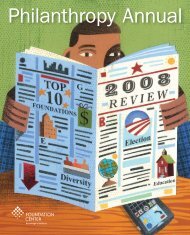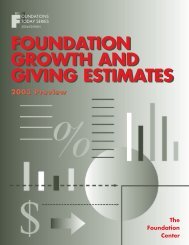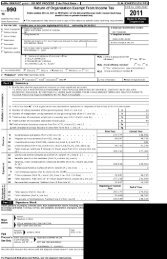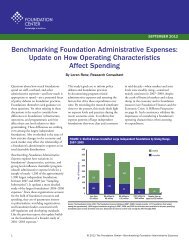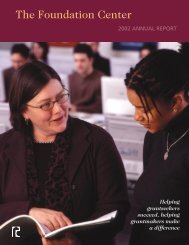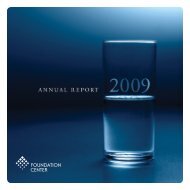Download Philanthropy Annual PDF - Foundation Center
Download Philanthropy Annual PDF - Foundation Center
Download Philanthropy Annual PDF - Foundation Center
Create successful ePaper yourself
Turn your PDF publications into a flip-book with our unique Google optimized e-Paper software.
will generate new leaders from all<br />
disciplines who are willing to lead nonprofit<br />
organizations at some point in<br />
their careers. One of the silver linings<br />
of the economic downturn might be<br />
that more people discover nonprofit<br />
work as a career option.<br />
PND: This is probably the most<br />
challenging fundraising environment<br />
in 30 years. Can veteran nonprofit<br />
leaders apply the lessons they have<br />
learned in the past to the current<br />
environment, or is this new territory<br />
for everyone?<br />
JR: It’s new territory for everyone.<br />
Many leaders, in both the nonprofit<br />
and for-profit sectors, have had the<br />
great good fortune of managing<br />
organizations in a strong economy,<br />
when the focus was on growth and<br />
expansion. Today’s environment, on<br />
the other hand, challenges leaders<br />
to rein in and even shrink the organizations<br />
that, in many cases, they<br />
have built. That’s very difficult.<br />
Another issue is the nonprofit<br />
sector has never had any great<br />
financing mechanisms or a good<br />
flow of capital into the sector. Meyer<br />
recently funded an Urban Institute<br />
study — the first of its kind — to<br />
find out if nonprofits in the metropolitan<br />
DC area have operating<br />
reserves. According to the findings,<br />
they don’t — or if they do,<br />
their reserves and working capital<br />
are insufficient. I think the report,<br />
Washington-Area Nonprofit Operating<br />
Reserves, will generate a lot of discussion<br />
in the sector. The undercapitalization<br />
of nonprofits is an issue<br />
the Meyer <strong>Foundation</strong> has been<br />
concerned about for a long time.<br />
PND: We look forward to reading the<br />
report. Thanks again for your time.<br />
JR: Thank you.<br />
— Alice Garrard and Matt Sinclair<br />
Make a Socially Responsible<br />
Investment in Young Black Men<br />
By Cedric Brown, Director, Mitchell Kapor <strong>Foundation</strong><br />
We had to do something.<br />
In 2004, the Mitchell Kapor <strong>Foundation</strong> began noticing a disturbing<br />
trend in the San Francisco Bay Area. Black male applicants were<br />
visibly absent from the selection pool for the educational programs<br />
run by our sister organization, the Level Playing Field Institute. At the<br />
same time, we were dismayed by the news of several shootings of<br />
young black men, among them a college-bound high school senior.<br />
We knew then that we had to do something.<br />
C o m m e n t a r y & O p i n i o n<br />
We dug deeper, and the numbers we uncovered<br />
painted a disturbing picture. In today’s<br />
tough economic climate, job loss is hitting<br />
black men the hardest, and research links education<br />
to that trend. In California, it is estimated that nearly<br />
half the state’s black male students drop out of high<br />
school. Even in the “knowledge economy”-based San<br />
Francisco Bay Area, black males are less likely to have<br />
high school or college degrees than the general population: 27 percent of black<br />
males in Oakland and 32 percent in San Francisco have a high school diploma<br />
or GED, while only 10 percent of black males in Oakland and 14 percent in San<br />
Francisco have a bachelor’s degree. Moreover, high school dropouts and those<br />
without a college degree are more likely to be jobless and incarcerated.<br />
Although young black men in our communities have tremendous potential,<br />
too often that potential is not being recognized or maximized. So we decided<br />
to do something: We launched an effort to invest in the phenomenal minds<br />
that exist in our communities, with the aim of getting youth away from the<br />
margins, helping them overcome obstacles, and supporting them on a path<br />
to college.<br />
Five years later, this past June, we celebrated the first cohort of collegebound<br />
graduating high school seniors from our Black Boys College Bound<br />
Initiative, a multiyear, $1 million effort aimed at increasing the number of black<br />
male youth in the Bay Area, particularly from San Francisco and Oakland, who<br />
are prepared for college.<br />
As part of the initiative’s first phase, we allocated grants of up to $50,000 to<br />
11 organizations. To date, our grantees have served nearly 400 Bay Area youth in<br />
middle and high schools with such programs as college readiness workshops, college<br />
tours, academic coaching, mentoring, mental health services for students and<br />
their families, social development and much more. This fall, more than 40 seniors<br />
will go on to college, serving as visible role models of success and possibility for<br />
other youth in their communities.<br />
People Who Make a Difference | 47



